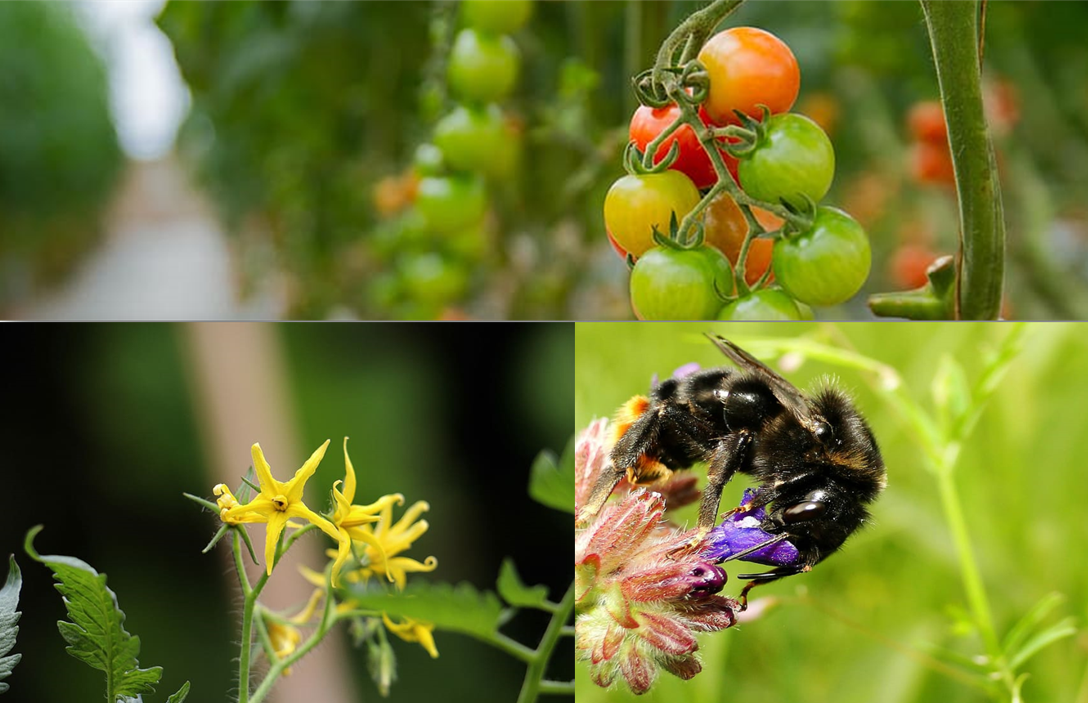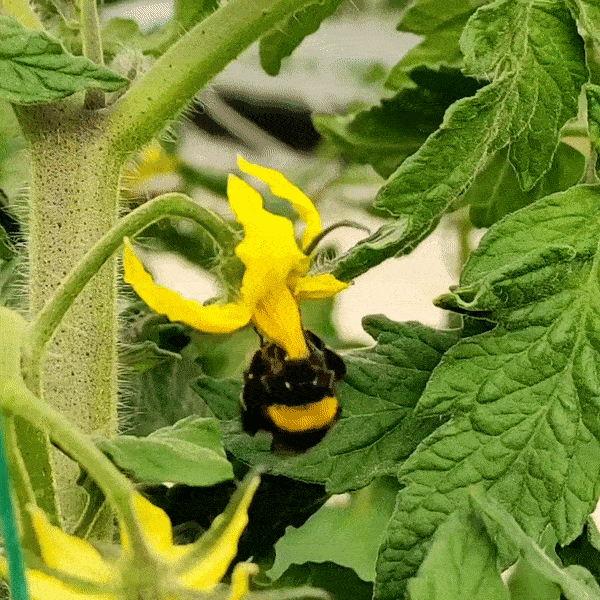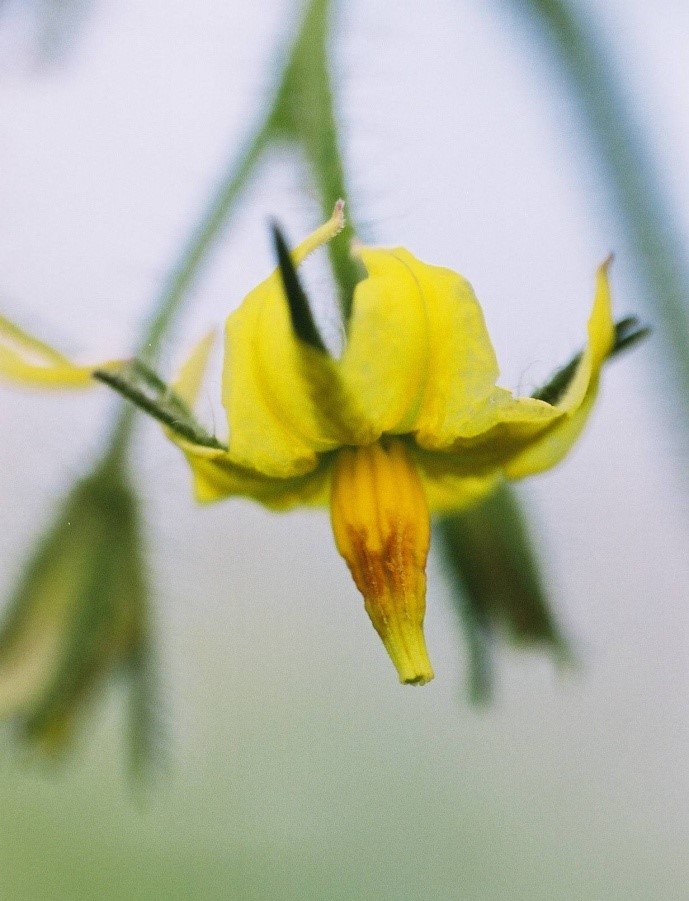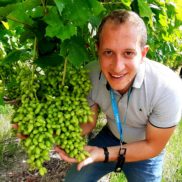Natural Pollination in greenhouse crops using bumblebees and other beneficial insects

This post is also available in:
This post is also available in:
![]() Español (Spanish)
Español (Spanish) ![]() Français (French)
Français (French) ![]() العربية (Arabic)
العربية (Arabic) ![]() Ελληνικά (Greek)
Ελληνικά (Greek)
Bumblebees are used to pollinate greenhouse crops since the late 80s. Until today they remain a very reliable source of pollination, especially in tomato crops. Before the development of commercial products with bumblebees, fruit formation was based on the use of synthetic auxins such as 2,4-D. Thus, bumblebees contribute to the reduction of chemical residues in fruits.

Picture 1 Bumblebee visit to tomato flower

Picture 2 Flower bruise after bumblebee pollination
The term “bumblebee” refers to the insects of the genus Bombus under the Hymenoptera Class. Bombus terrestris is the most common species used in greenhouses. Pollination is achieved by the strong thoracic vibrations produced by the bumblebee, which are transmitted through its legs to the flowers (Picture 1). After a flower visit, the bumblebee leaves a mark on the flower which resembles a bruise (Picture 2) and is a sign of successful pollination.Picture 1 Bumblebee visit to tomato flowerPicture 2 Flower bruise after bumblebee pollination

Picture 3. Parts of a commercial bumblebee hive for use in greenhouse crops. Source: Bioline Agrosciences
A commercial hive consists of the queen, workers and brood. To cover their energy needs, they are supplied with sugar water (picture 3). Workers are in need to feed the young brood and they look for pollen, therefore they pollinate crop flowers. The emergence of brood from the cells will increase the population of pollinators and subsequently a larger portion of flowers will be visited. The travel distance of workers is quite high and can reach up to 3 km away from the hive. In practice, a single hive is used to cover a 2000m2 greenhouse area.Picture 3. Parts of a commercial bumblebee hive for use in greenhouse crops. Source: Bioline Agrosciences
Optimal conditions for natural pollination
Many biotic and abiotic factors can influence the quality of pollination in greenhouse crops.
Plant fitness and vigor are of high importance to achieve good pollination. For instance, when many lateral shoots are left to grow on the crop, then there will be a period of time with a large number of open flowers. In this case, if the existing number of hives is not sufficient to assure flower fertilization, then it is recommended to add an additional hive(s) into the greenhouse. The amount of water given to the plants (irrigation) can affect the quality of the pollen and hence the development of the hive itself. Water stress can cause bad pollen resulting in unattractive flowers for the bumblebees.
Environmental conditions such as temperature, humidity, and radiation play the most critical role in optimal pollination. Generally, a temperature (T) and relative humidity (RH) range between 23-28 oC and 60-75% respectively is considered an excellent combination for pollination. Temperatures above 30oC cause bumblebees to stay inside the hive and spend more time on temperature regulation instead of foraging. In cases of high temperatures, it is advisable to take protective measures such as the use of cooling and shading systems. Regarding relative humidity, values outside the optimal range can cause either too dry (low RH) or sticky pollen (high RH) making it less attractive to bumblebees and not suitable for the flower stigma.
Obviously biotic and abiotic factors do not act independently, as harsh environmental conditions reduce the strength of the plant and promote the vegetative stage instead of the flowering and fruit setting. It is good to keep in mind that these guidelines are indicative and the influence of these conditions can vary a lot among different cultivated varieties.
Practical advice: How to place a bumblebee hive in the greenhouse
- The hive should be transported in an upright position until its final placement in the greenhouse
- Do not place the hive in places where there is water leakage or the environment around the hive is wet
- Make sure that the exit flight hole is clear, and nothing is blocking it
- If two hives are concentrated at the same level, the exit-flight holes must ‘look’ in different directions
- The exit-flight hole must not be exposed to direct sunlight
- Place the hives low on the crop, where there is enough shade, but not in a cold place and not high above the crop in direct sunlight.
- Wait at least 2 hours before opening the hive. This helps the bumblebees to calm down and settle.
- Do not move the hive after opening. Do not push or shake the hive
- During the summer season when high temperatures prevail, open the hive late in the afternoon. Placement of new hives in the greenhouse should be done very early in the morning or preferably in the evening.
- If a hive is removed from its position, place the new hive in the same position to avoid confusion with other bees.
- In a sugar-depleted hive, the bumblebees may still be active. Check regularly and supply the hive with sugar water.
- Provide the colony with pollen in case of short flowering of the crop.
- Ants are often attracted to hives due to the presence of sugars. Try to keep ants away from the hive using bait stations or grease around the hive location.
Compatibility with plant protection products
Farmers often spray their crops against various pests and diseases with substances that may be toxic to pollinators. Bumblebee hive producers provide comprehensive lists and databases regarding the compatibility of Plant Protection Products (PPP) with bumblebees. Newly developed active ingredients tend to be friendlier with bumblebees and require the closure of the hive only for a few hours after the application. In case the farmer detects a significant disturbance in the behavior of the pollinators or the size of their population, he/she must consider changing the product used and if needed, replacing the hive(s) affected.
Other beneficial pollinators
Hoverflies are insects that feed on a variety of sources. Adults are often found in flowers feeding with pollen and nectar (Picture 4) while larvae can either feed on organic matter or on other insects as predators. Recently, two species (now commercially available) which are used to treat aphid infestations, found to significantly increase fruit set and fruit weight in sweet pepper plants under greenhouse conditions. In other words, the same organism is able to provide biocontrol and pollination services at the same time with a great benefit to the farmer.

Picture 4. Hoverfly Sphaerophoria contigua feeding on a flower. Source: Encyclopedia of life
References
Godfrey Dol and Remco Huvermann, Plant Pollinator Interaction in High Temperatures. Whitepaper version 1.0 June 30, 2020
Kraus, F. B., S. Wolf, and R. F. Moritz. 2009. Male flight distance and population substructure in the bumblebee Bombus terrestris. J Anim Ecol 78:247-252.
Morandin, L., T. Laverty, and P. Kevan. 2001. Bumblebee (Hymenoptera: Apidae) activity and pollination levels in commercial tomato greenhouses. Journal of economic entomology 94:462-467.
Pekas, A., I. De Craecker, S. Boonen, F. L. Wäckers, and R. Moerkens. 2020. One stone; two birds: concurrent pest control and pollination services provided by aphidophagous hoverflies. Biological Control 149.
Velthuis, H. H. W., and A. van Doorn. 2006. A century of advances in bumblebee domestication and the economic and environmental aspects of its commercialization for pollination. Apidologie 37:421-451.








































































